Key Sources of Laws for Business Organizations in the UK
VerifiedAdded on 2023/06/14
|9
|2411
|193
AI Summary
This report describes the legal context for business organizations in the UK and the key sources of laws that govern them. It covers the legal business structure of UK companies, including sole trader, general partnership, partnership, and limited liability. It also provides recommendations for IOM Solutions.
Contribute Materials
Your contribution can guide someone’s learning journey. Share your
documents today.
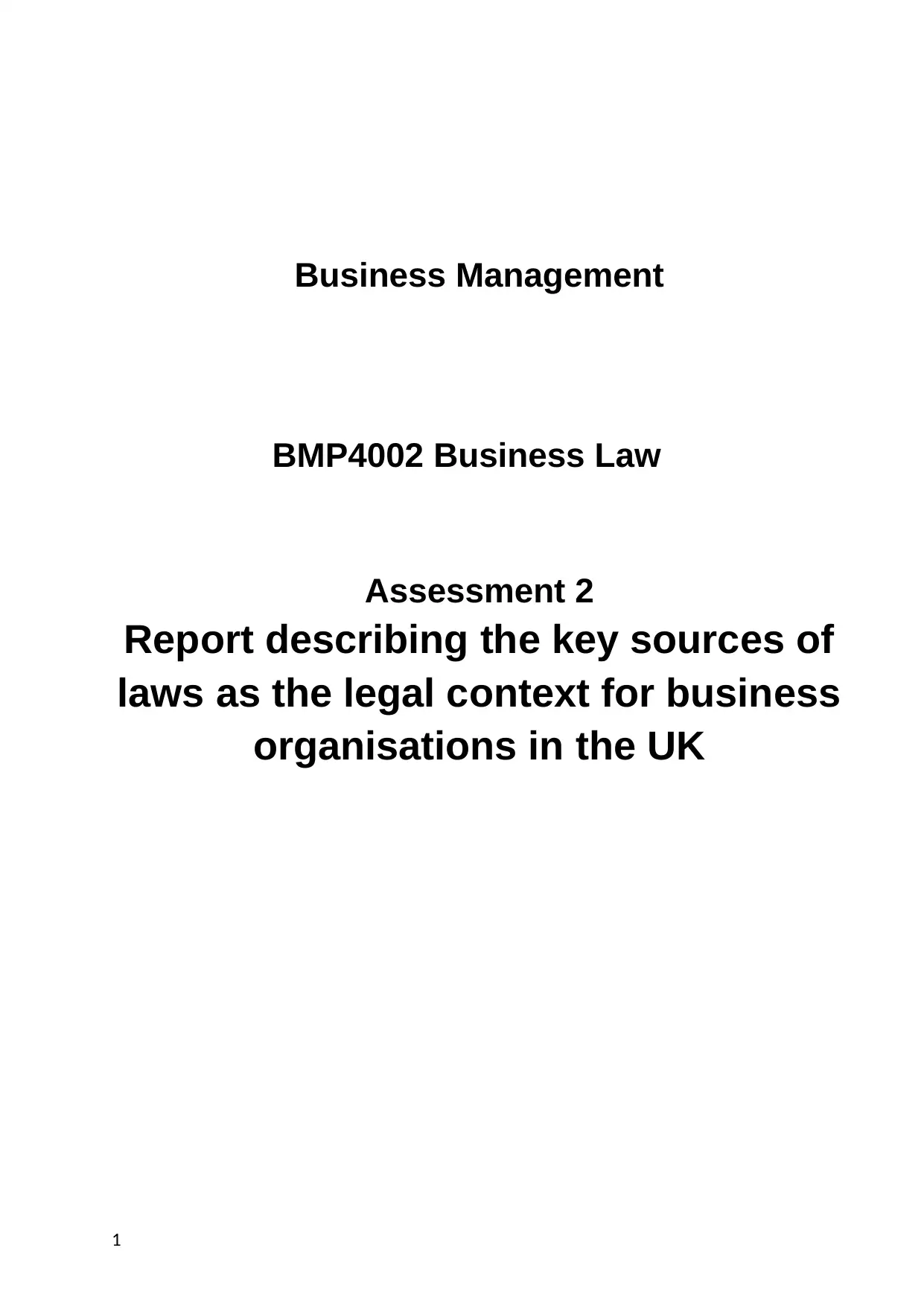
Business Management
BMP4002 Business Law
Assessment 2
Report describing the key sources of
laws as the legal context for business
organisations in the UK
1
BMP4002 Business Law
Assessment 2
Report describing the key sources of
laws as the legal context for business
organisations in the UK
1
Secure Best Marks with AI Grader
Need help grading? Try our AI Grader for instant feedback on your assignments.
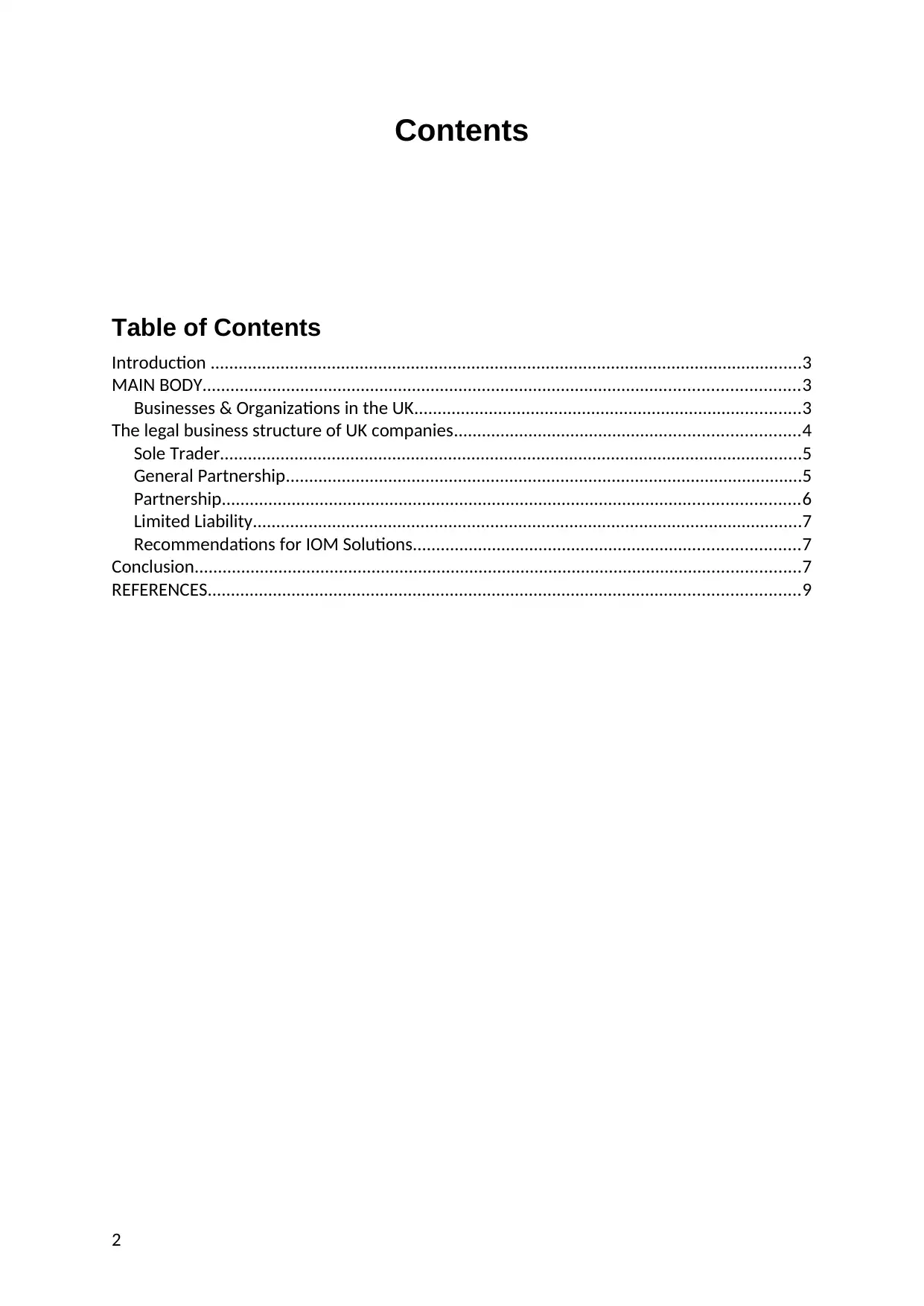
Contents
Table of Contents
Introduction ...............................................................................................................................3
MAIN BODY................................................................................................................................3
Businesses & Organizations in the UK...................................................................................3
The legal business structure of UK companies..........................................................................4
Sole Trader.............................................................................................................................5
General Partnership...............................................................................................................5
Partnership............................................................................................................................6
Limited Liability......................................................................................................................7
Recommendations for IOM Solutions...................................................................................7
Conclusion..................................................................................................................................7
REFERENCES...............................................................................................................................9
2
Table of Contents
Introduction ...............................................................................................................................3
MAIN BODY................................................................................................................................3
Businesses & Organizations in the UK...................................................................................3
The legal business structure of UK companies..........................................................................4
Sole Trader.............................................................................................................................5
General Partnership...............................................................................................................5
Partnership............................................................................................................................6
Limited Liability......................................................................................................................7
Recommendations for IOM Solutions...................................................................................7
Conclusion..................................................................................................................................7
REFERENCES...............................................................................................................................9
2
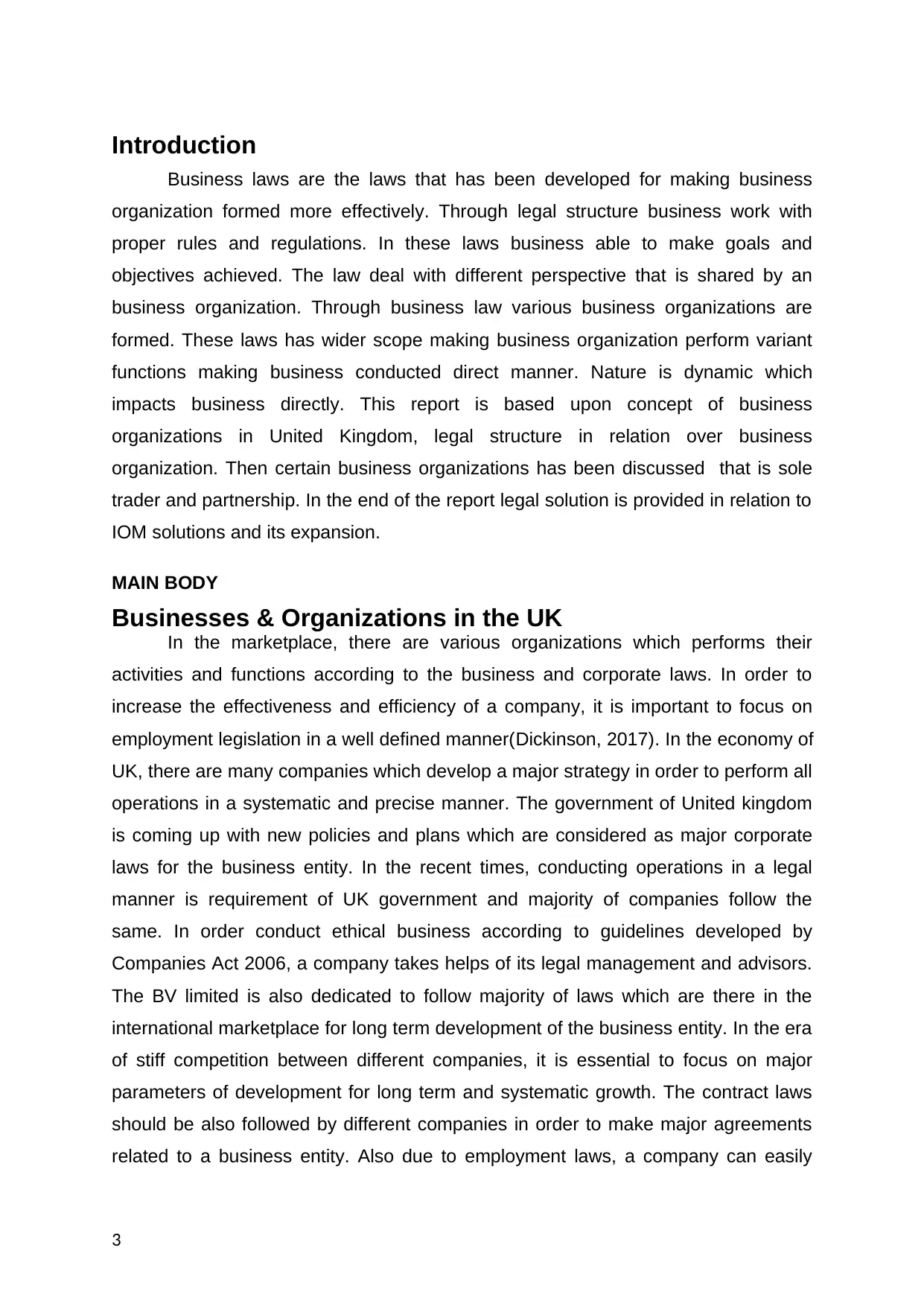
Introduction
Business laws are the laws that has been developed for making business
organization formed more effectively. Through legal structure business work with
proper rules and regulations. In these laws business able to make goals and
objectives achieved. The law deal with different perspective that is shared by an
business organization. Through business law various business organizations are
formed. These laws has wider scope making business organization perform variant
functions making business conducted direct manner. Nature is dynamic which
impacts business directly. This report is based upon concept of business
organizations in United Kingdom, legal structure in relation over business
organization. Then certain business organizations has been discussed that is sole
trader and partnership. In the end of the report legal solution is provided in relation to
IOM solutions and its expansion.
MAIN BODY
Businesses & Organizations in the UK
In the marketplace, there are various organizations which performs their
activities and functions according to the business and corporate laws. In order to
increase the effectiveness and efficiency of a company, it is important to focus on
employment legislation in a well defined manner(Dickinson, 2017). In the economy of
UK, there are many companies which develop a major strategy in order to perform all
operations in a systematic and precise manner. The government of United kingdom
is coming up with new policies and plans which are considered as major corporate
laws for the business entity. In the recent times, conducting operations in a legal
manner is requirement of UK government and majority of companies follow the
same. In order conduct ethical business according to guidelines developed by
Companies Act 2006, a company takes helps of its legal management and advisors.
The BV limited is also dedicated to follow majority of laws which are there in the
international marketplace for long term development of the business entity. In the era
of stiff competition between different companies, it is essential to focus on major
parameters of development for long term and systematic growth. The contract laws
should be also followed by different companies in order to make major agreements
related to a business entity. Also due to employment laws, a company can easily
3
Business laws are the laws that has been developed for making business
organization formed more effectively. Through legal structure business work with
proper rules and regulations. In these laws business able to make goals and
objectives achieved. The law deal with different perspective that is shared by an
business organization. Through business law various business organizations are
formed. These laws has wider scope making business organization perform variant
functions making business conducted direct manner. Nature is dynamic which
impacts business directly. This report is based upon concept of business
organizations in United Kingdom, legal structure in relation over business
organization. Then certain business organizations has been discussed that is sole
trader and partnership. In the end of the report legal solution is provided in relation to
IOM solutions and its expansion.
MAIN BODY
Businesses & Organizations in the UK
In the marketplace, there are various organizations which performs their
activities and functions according to the business and corporate laws. In order to
increase the effectiveness and efficiency of a company, it is important to focus on
employment legislation in a well defined manner(Dickinson, 2017). In the economy of
UK, there are many companies which develop a major strategy in order to perform all
operations in a systematic and precise manner. The government of United kingdom
is coming up with new policies and plans which are considered as major corporate
laws for the business entity. In the recent times, conducting operations in a legal
manner is requirement of UK government and majority of companies follow the
same. In order conduct ethical business according to guidelines developed by
Companies Act 2006, a company takes helps of its legal management and advisors.
The BV limited is also dedicated to follow majority of laws which are there in the
international marketplace for long term development of the business entity. In the era
of stiff competition between different companies, it is essential to focus on major
parameters of development for long term and systematic growth. The contract laws
should be also followed by different companies in order to make major agreements
related to a business entity. Also due to employment laws, a company can easily
3
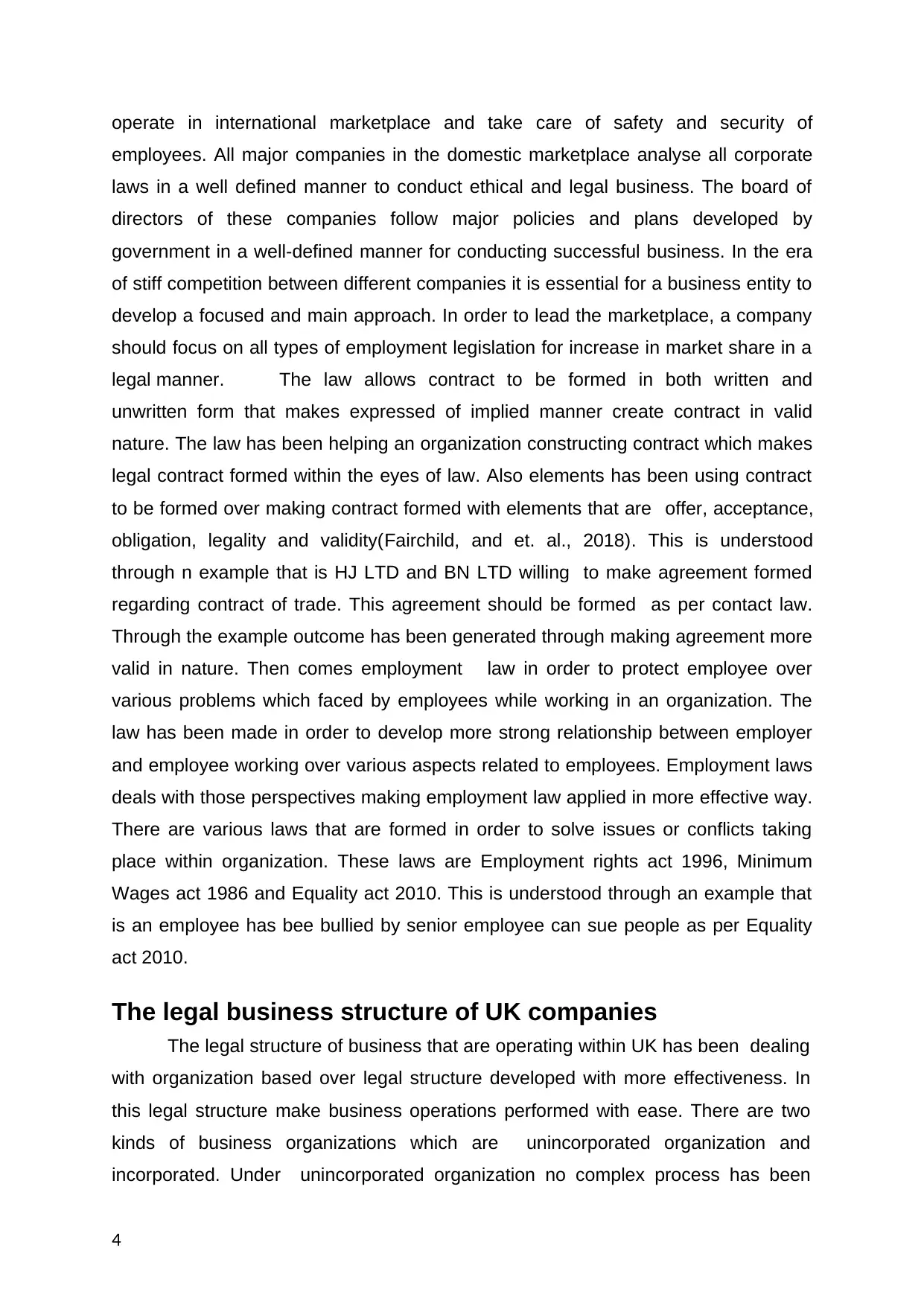
operate in international marketplace and take care of safety and security of
employees. All major companies in the domestic marketplace analyse all corporate
laws in a well defined manner to conduct ethical and legal business. The board of
directors of these companies follow major policies and plans developed by
government in a well-defined manner for conducting successful business. In the era
of stiff competition between different companies it is essential for a business entity to
develop a focused and main approach. In order to lead the marketplace, a company
should focus on all types of employment legislation for increase in market share in a
legal manner. The law allows contract to be formed in both written and
unwritten form that makes expressed of implied manner create contract in valid
nature. The law has been helping an organization constructing contract which makes
legal contract formed within the eyes of law. Also elements has been using contract
to be formed over making contract formed with elements that are offer, acceptance,
obligation, legality and validity(Fairchild, and et. al., 2018). This is understood
through n example that is HJ LTD and BN LTD willing to make agreement formed
regarding contract of trade. This agreement should be formed as per contact law.
Through the example outcome has been generated through making agreement more
valid in nature. Then comes employment law in order to protect employee over
various problems which faced by employees while working in an organization. The
law has been made in order to develop more strong relationship between employer
and employee working over various aspects related to employees. Employment laws
deals with those perspectives making employment law applied in more effective way.
There are various laws that are formed in order to solve issues or conflicts taking
place within organization. These laws are Employment rights act 1996, Minimum
Wages act 1986 and Equality act 2010. This is understood through an example that
is an employee has bee bullied by senior employee can sue people as per Equality
act 2010.
The legal business structure of UK companies
The legal structure of business that are operating within UK has been dealing
with organization based over legal structure developed with more effectiveness. In
this legal structure make business operations performed with ease. There are two
kinds of business organizations which are unincorporated organization and
incorporated. Under unincorporated organization no complex process has been
4
employees. All major companies in the domestic marketplace analyse all corporate
laws in a well defined manner to conduct ethical and legal business. The board of
directors of these companies follow major policies and plans developed by
government in a well-defined manner for conducting successful business. In the era
of stiff competition between different companies it is essential for a business entity to
develop a focused and main approach. In order to lead the marketplace, a company
should focus on all types of employment legislation for increase in market share in a
legal manner. The law allows contract to be formed in both written and
unwritten form that makes expressed of implied manner create contract in valid
nature. The law has been helping an organization constructing contract which makes
legal contract formed within the eyes of law. Also elements has been using contract
to be formed over making contract formed with elements that are offer, acceptance,
obligation, legality and validity(Fairchild, and et. al., 2018). This is understood
through n example that is HJ LTD and BN LTD willing to make agreement formed
regarding contract of trade. This agreement should be formed as per contact law.
Through the example outcome has been generated through making agreement more
valid in nature. Then comes employment law in order to protect employee over
various problems which faced by employees while working in an organization. The
law has been made in order to develop more strong relationship between employer
and employee working over various aspects related to employees. Employment laws
deals with those perspectives making employment law applied in more effective way.
There are various laws that are formed in order to solve issues or conflicts taking
place within organization. These laws are Employment rights act 1996, Minimum
Wages act 1986 and Equality act 2010. This is understood through an example that
is an employee has bee bullied by senior employee can sue people as per Equality
act 2010.
The legal business structure of UK companies
The legal structure of business that are operating within UK has been dealing
with organization based over legal structure developed with more effectiveness. In
this legal structure make business operations performed with ease. There are two
kinds of business organizations which are unincorporated organization and
incorporated. Under unincorporated organization no complex process has been
4
Secure Best Marks with AI Grader
Need help grading? Try our AI Grader for instant feedback on your assignments.
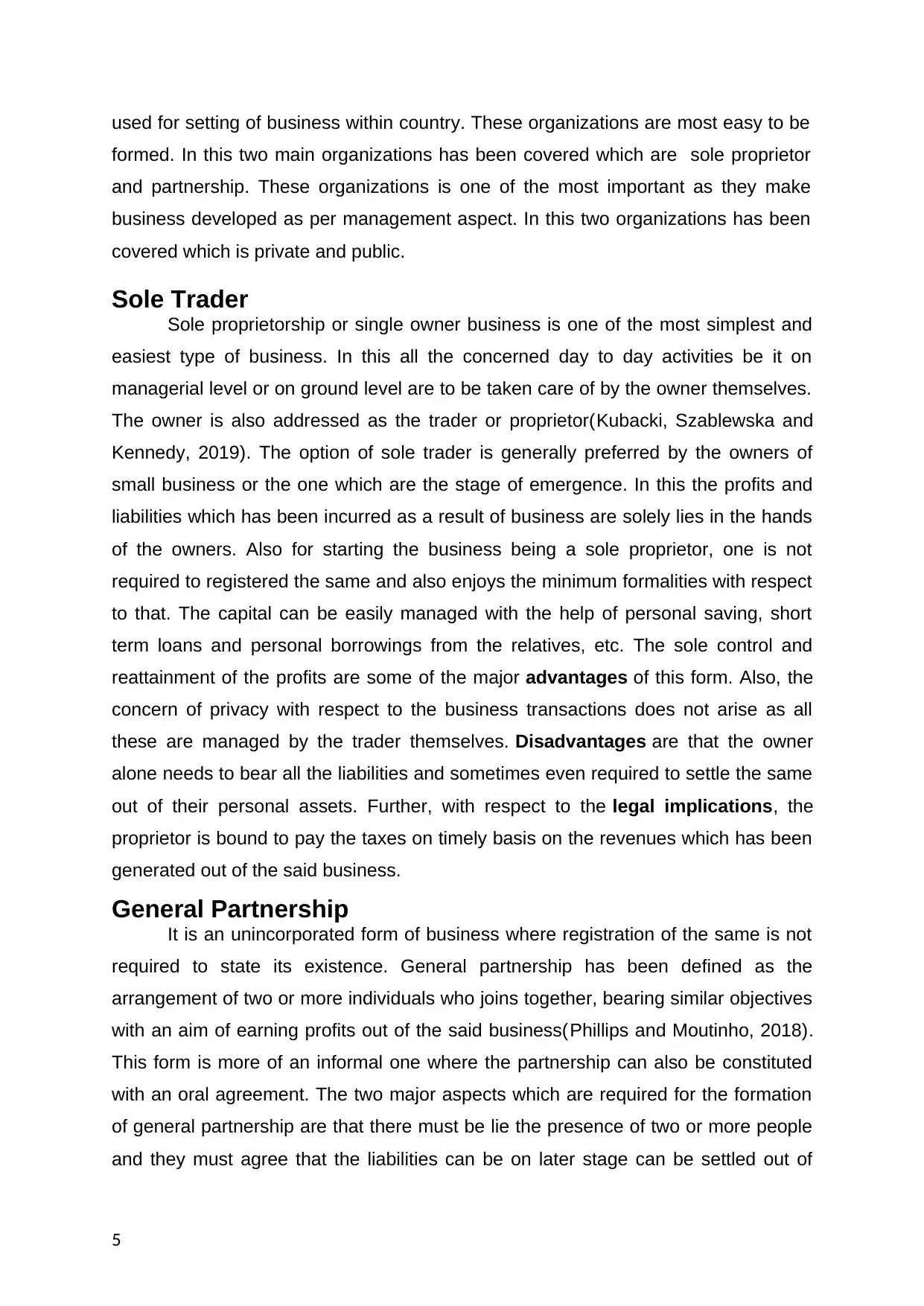
used for setting of business within country. These organizations are most easy to be
formed. In this two main organizations has been covered which are sole proprietor
and partnership. These organizations is one of the most important as they make
business developed as per management aspect. In this two organizations has been
covered which is private and public.
Sole Trader
Sole proprietorship or single owner business is one of the most simplest and
easiest type of business. In this all the concerned day to day activities be it on
managerial level or on ground level are to be taken care of by the owner themselves.
The owner is also addressed as the trader or proprietor(Kubacki, Szablewska and
Kennedy, 2019). The option of sole trader is generally preferred by the owners of
small business or the one which are the stage of emergence. In this the profits and
liabilities which has been incurred as a result of business are solely lies in the hands
of the owners. Also for starting the business being a sole proprietor, one is not
required to registered the same and also enjoys the minimum formalities with respect
to that. The capital can be easily managed with the help of personal saving, short
term loans and personal borrowings from the relatives, etc. The sole control and
reattainment of the profits are some of the major advantages of this form. Also, the
concern of privacy with respect to the business transactions does not arise as all
these are managed by the trader themselves. Disadvantages are that the owner
alone needs to bear all the liabilities and sometimes even required to settle the same
out of their personal assets. Further, with respect to the legal implications, the
proprietor is bound to pay the taxes on timely basis on the revenues which has been
generated out of the said business.
General Partnership
It is an unincorporated form of business where registration of the same is not
required to state its existence. General partnership has been defined as the
arrangement of two or more individuals who joins together, bearing similar objectives
with an aim of earning profits out of the said business(Phillips and Moutinho, 2018).
This form is more of an informal one where the partnership can also be constituted
with an oral agreement. The two major aspects which are required for the formation
of general partnership are that there must be lie the presence of two or more people
and they must agree that the liabilities can be on later stage can be settled out of
5
formed. In this two main organizations has been covered which are sole proprietor
and partnership. These organizations is one of the most important as they make
business developed as per management aspect. In this two organizations has been
covered which is private and public.
Sole Trader
Sole proprietorship or single owner business is one of the most simplest and
easiest type of business. In this all the concerned day to day activities be it on
managerial level or on ground level are to be taken care of by the owner themselves.
The owner is also addressed as the trader or proprietor(Kubacki, Szablewska and
Kennedy, 2019). The option of sole trader is generally preferred by the owners of
small business or the one which are the stage of emergence. In this the profits and
liabilities which has been incurred as a result of business are solely lies in the hands
of the owners. Also for starting the business being a sole proprietor, one is not
required to registered the same and also enjoys the minimum formalities with respect
to that. The capital can be easily managed with the help of personal saving, short
term loans and personal borrowings from the relatives, etc. The sole control and
reattainment of the profits are some of the major advantages of this form. Also, the
concern of privacy with respect to the business transactions does not arise as all
these are managed by the trader themselves. Disadvantages are that the owner
alone needs to bear all the liabilities and sometimes even required to settle the same
out of their personal assets. Further, with respect to the legal implications, the
proprietor is bound to pay the taxes on timely basis on the revenues which has been
generated out of the said business.
General Partnership
It is an unincorporated form of business where registration of the same is not
required to state its existence. General partnership has been defined as the
arrangement of two or more individuals who joins together, bearing similar objectives
with an aim of earning profits out of the said business(Phillips and Moutinho, 2018).
This form is more of an informal one where the partnership can also be constituted
with an oral agreement. The two major aspects which are required for the formation
of general partnership are that there must be lie the presence of two or more people
and they must agree that the liabilities can be on later stage can be settled out of
5
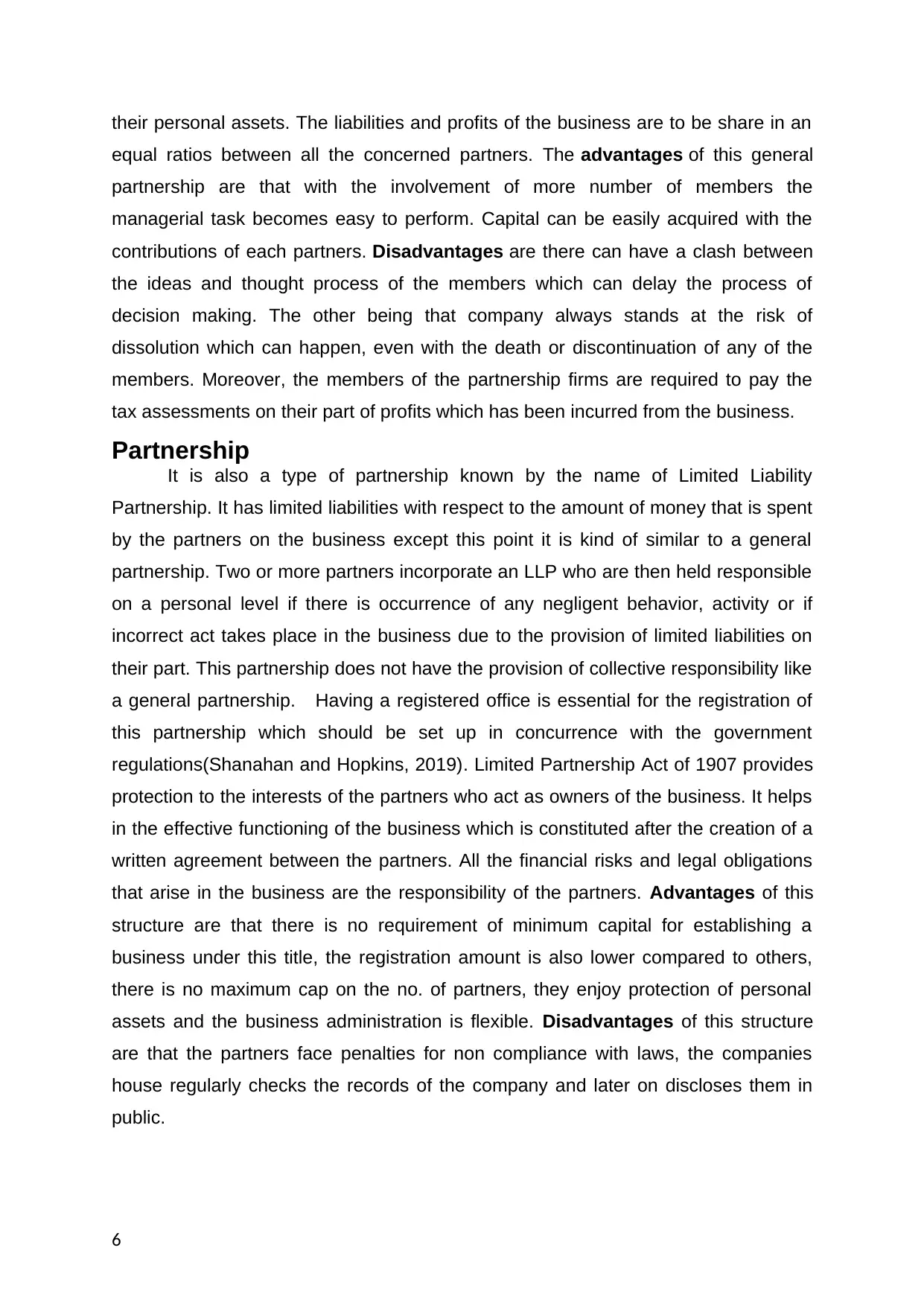
their personal assets. The liabilities and profits of the business are to be share in an
equal ratios between all the concerned partners. The advantages of this general
partnership are that with the involvement of more number of members the
managerial task becomes easy to perform. Capital can be easily acquired with the
contributions of each partners. Disadvantages are there can have a clash between
the ideas and thought process of the members which can delay the process of
decision making. The other being that company always stands at the risk of
dissolution which can happen, even with the death or discontinuation of any of the
members. Moreover, the members of the partnership firms are required to pay the
tax assessments on their part of profits which has been incurred from the business.
Partnership
It is also a type of partnership known by the name of Limited Liability
Partnership. It has limited liabilities with respect to the amount of money that is spent
by the partners on the business except this point it is kind of similar to a general
partnership. Two or more partners incorporate an LLP who are then held responsible
on a personal level if there is occurrence of any negligent behavior, activity or if
incorrect act takes place in the business due to the provision of limited liabilities on
their part. This partnership does not have the provision of collective responsibility like
a general partnership. Having a registered office is essential for the registration of
this partnership which should be set up in concurrence with the government
regulations(Shanahan and Hopkins, 2019). Limited Partnership Act of 1907 provides
protection to the interests of the partners who act as owners of the business. It helps
in the effective functioning of the business which is constituted after the creation of a
written agreement between the partners. All the financial risks and legal obligations
that arise in the business are the responsibility of the partners. Advantages of this
structure are that there is no requirement of minimum capital for establishing a
business under this title, the registration amount is also lower compared to others,
there is no maximum cap on the no. of partners, they enjoy protection of personal
assets and the business administration is flexible. Disadvantages of this structure
are that the partners face penalties for non compliance with laws, the companies
house regularly checks the records of the company and later on discloses them in
public.
6
equal ratios between all the concerned partners. The advantages of this general
partnership are that with the involvement of more number of members the
managerial task becomes easy to perform. Capital can be easily acquired with the
contributions of each partners. Disadvantages are there can have a clash between
the ideas and thought process of the members which can delay the process of
decision making. The other being that company always stands at the risk of
dissolution which can happen, even with the death or discontinuation of any of the
members. Moreover, the members of the partnership firms are required to pay the
tax assessments on their part of profits which has been incurred from the business.
Partnership
It is also a type of partnership known by the name of Limited Liability
Partnership. It has limited liabilities with respect to the amount of money that is spent
by the partners on the business except this point it is kind of similar to a general
partnership. Two or more partners incorporate an LLP who are then held responsible
on a personal level if there is occurrence of any negligent behavior, activity or if
incorrect act takes place in the business due to the provision of limited liabilities on
their part. This partnership does not have the provision of collective responsibility like
a general partnership. Having a registered office is essential for the registration of
this partnership which should be set up in concurrence with the government
regulations(Shanahan and Hopkins, 2019). Limited Partnership Act of 1907 provides
protection to the interests of the partners who act as owners of the business. It helps
in the effective functioning of the business which is constituted after the creation of a
written agreement between the partners. All the financial risks and legal obligations
that arise in the business are the responsibility of the partners. Advantages of this
structure are that there is no requirement of minimum capital for establishing a
business under this title, the registration amount is also lower compared to others,
there is no maximum cap on the no. of partners, they enjoy protection of personal
assets and the business administration is flexible. Disadvantages of this structure
are that the partners face penalties for non compliance with laws, the companies
house regularly checks the records of the company and later on discloses them in
public.
6
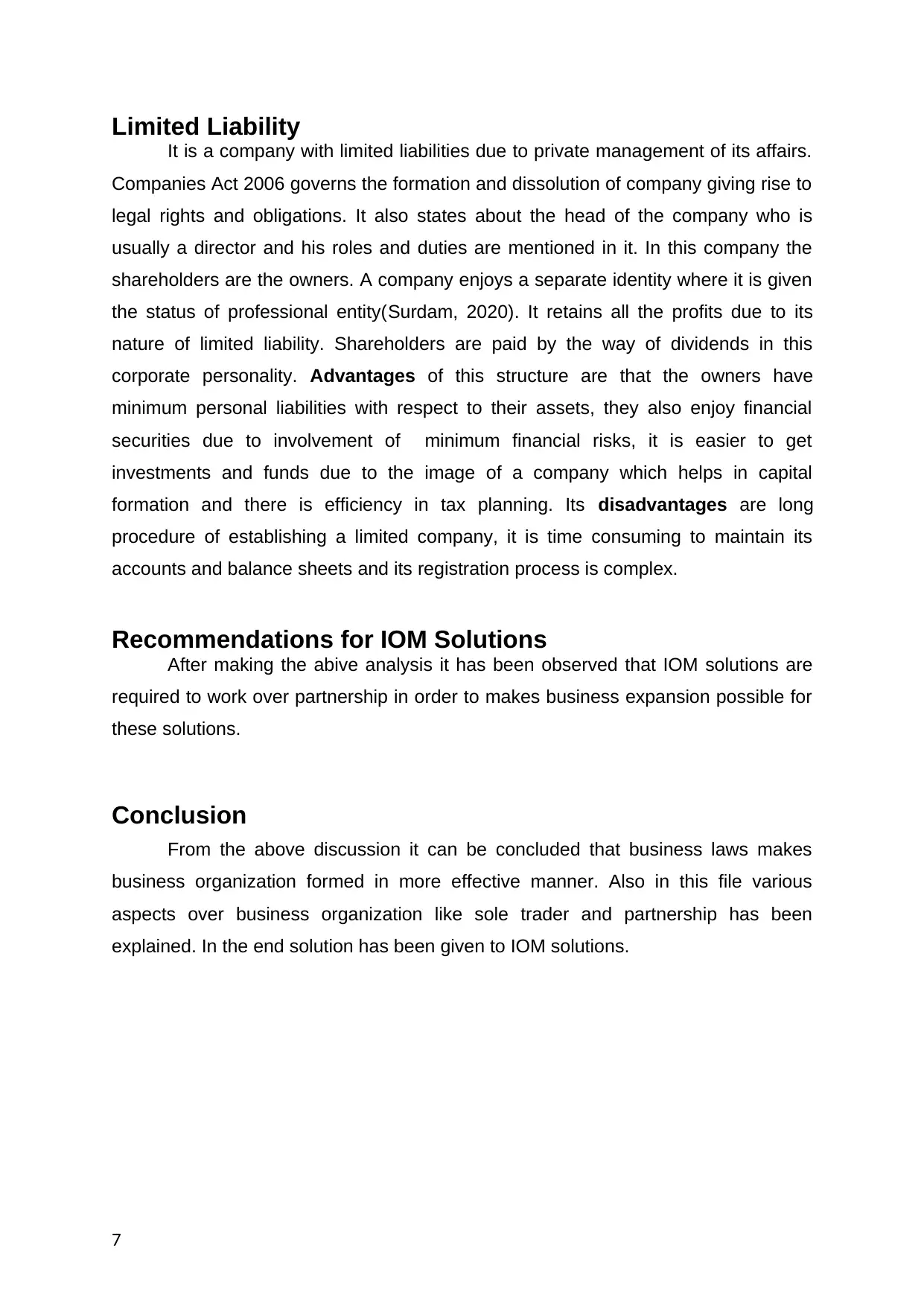
Limited Liability
It is a company with limited liabilities due to private management of its affairs.
Companies Act 2006 governs the formation and dissolution of company giving rise to
legal rights and obligations. It also states about the head of the company who is
usually a director and his roles and duties are mentioned in it. In this company the
shareholders are the owners. A company enjoys a separate identity where it is given
the status of professional entity(Surdam, 2020). It retains all the profits due to its
nature of limited liability. Shareholders are paid by the way of dividends in this
corporate personality. Advantages of this structure are that the owners have
minimum personal liabilities with respect to their assets, they also enjoy financial
securities due to involvement of minimum financial risks, it is easier to get
investments and funds due to the image of a company which helps in capital
formation and there is efficiency in tax planning. Its disadvantages are long
procedure of establishing a limited company, it is time consuming to maintain its
accounts and balance sheets and its registration process is complex.
Recommendations for IOM Solutions
After making the abive analysis it has been observed that IOM solutions are
required to work over partnership in order to makes business expansion possible for
these solutions.
Conclusion
From the above discussion it can be concluded that business laws makes
business organization formed in more effective manner. Also in this file various
aspects over business organization like sole trader and partnership has been
explained. In the end solution has been given to IOM solutions.
7
It is a company with limited liabilities due to private management of its affairs.
Companies Act 2006 governs the formation and dissolution of company giving rise to
legal rights and obligations. It also states about the head of the company who is
usually a director and his roles and duties are mentioned in it. In this company the
shareholders are the owners. A company enjoys a separate identity where it is given
the status of professional entity(Surdam, 2020). It retains all the profits due to its
nature of limited liability. Shareholders are paid by the way of dividends in this
corporate personality. Advantages of this structure are that the owners have
minimum personal liabilities with respect to their assets, they also enjoy financial
securities due to involvement of minimum financial risks, it is easier to get
investments and funds due to the image of a company which helps in capital
formation and there is efficiency in tax planning. Its disadvantages are long
procedure of establishing a limited company, it is time consuming to maintain its
accounts and balance sheets and its registration process is complex.
Recommendations for IOM Solutions
After making the abive analysis it has been observed that IOM solutions are
required to work over partnership in order to makes business expansion possible for
these solutions.
Conclusion
From the above discussion it can be concluded that business laws makes
business organization formed in more effective manner. Also in this file various
aspects over business organization like sole trader and partnership has been
explained. In the end solution has been given to IOM solutions.
7
Paraphrase This Document
Need a fresh take? Get an instant paraphrase of this document with our AI Paraphraser

8
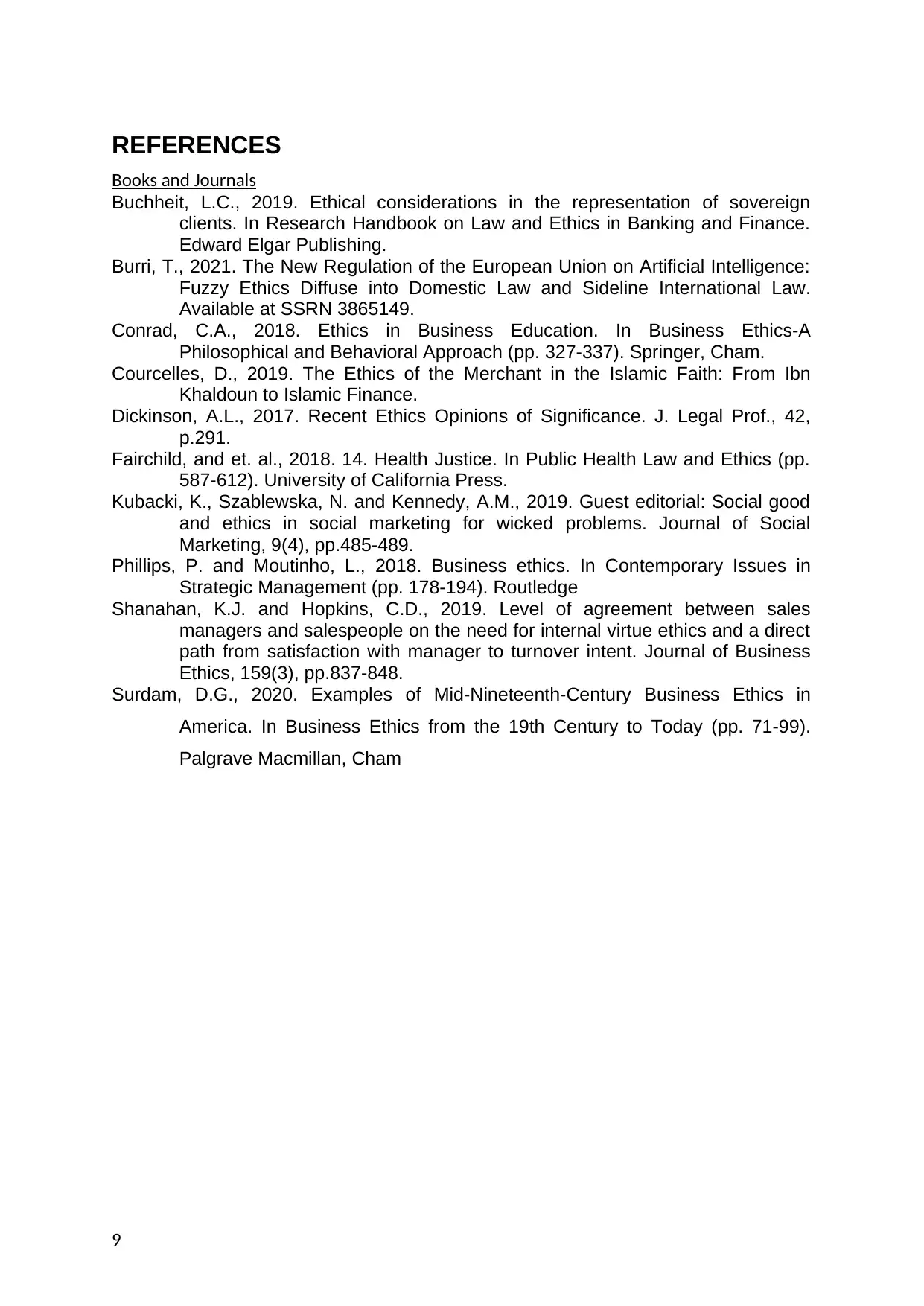
REFERENCES
Books and Journals
Buchheit, L.C., 2019. Ethical considerations in the representation of sovereign
clients. In Research Handbook on Law and Ethics in Banking and Finance.
Edward Elgar Publishing.
Burri, T., 2021. The New Regulation of the European Union on Artificial Intelligence:
Fuzzy Ethics Diffuse into Domestic Law and Sideline International Law.
Available at SSRN 3865149.
Conrad, C.A., 2018. Ethics in Business Education. In Business Ethics-A
Philosophical and Behavioral Approach (pp. 327-337). Springer, Cham.
Courcelles, D., 2019. The Ethics of the Merchant in the Islamic Faith: From Ibn
Khaldoun to Islamic Finance.
Dickinson, A.L., 2017. Recent Ethics Opinions of Significance. J. Legal Prof., 42,
p.291.
Fairchild, and et. al., 2018. 14. Health Justice. In Public Health Law and Ethics (pp.
587-612). University of California Press.
Kubacki, K., Szablewska, N. and Kennedy, A.M., 2019. Guest editorial: Social good
and ethics in social marketing for wicked problems. Journal of Social
Marketing, 9(4), pp.485-489.
Phillips, P. and Moutinho, L., 2018. Business ethics. In Contemporary Issues in
Strategic Management (pp. 178-194). Routledge
Shanahan, K.J. and Hopkins, C.D., 2019. Level of agreement between sales
managers and salespeople on the need for internal virtue ethics and a direct
path from satisfaction with manager to turnover intent. Journal of Business
Ethics, 159(3), pp.837-848.
Surdam, D.G., 2020. Examples of Mid-Nineteenth-Century Business Ethics in
America. In Business Ethics from the 19th Century to Today (pp. 71-99).
Palgrave Macmillan, Cham
9
Books and Journals
Buchheit, L.C., 2019. Ethical considerations in the representation of sovereign
clients. In Research Handbook on Law and Ethics in Banking and Finance.
Edward Elgar Publishing.
Burri, T., 2021. The New Regulation of the European Union on Artificial Intelligence:
Fuzzy Ethics Diffuse into Domestic Law and Sideline International Law.
Available at SSRN 3865149.
Conrad, C.A., 2018. Ethics in Business Education. In Business Ethics-A
Philosophical and Behavioral Approach (pp. 327-337). Springer, Cham.
Courcelles, D., 2019. The Ethics of the Merchant in the Islamic Faith: From Ibn
Khaldoun to Islamic Finance.
Dickinson, A.L., 2017. Recent Ethics Opinions of Significance. J. Legal Prof., 42,
p.291.
Fairchild, and et. al., 2018. 14. Health Justice. In Public Health Law and Ethics (pp.
587-612). University of California Press.
Kubacki, K., Szablewska, N. and Kennedy, A.M., 2019. Guest editorial: Social good
and ethics in social marketing for wicked problems. Journal of Social
Marketing, 9(4), pp.485-489.
Phillips, P. and Moutinho, L., 2018. Business ethics. In Contemporary Issues in
Strategic Management (pp. 178-194). Routledge
Shanahan, K.J. and Hopkins, C.D., 2019. Level of agreement between sales
managers and salespeople on the need for internal virtue ethics and a direct
path from satisfaction with manager to turnover intent. Journal of Business
Ethics, 159(3), pp.837-848.
Surdam, D.G., 2020. Examples of Mid-Nineteenth-Century Business Ethics in
America. In Business Ethics from the 19th Century to Today (pp. 71-99).
Palgrave Macmillan, Cham
9
1 out of 9
Related Documents
Your All-in-One AI-Powered Toolkit for Academic Success.
+13062052269
info@desklib.com
Available 24*7 on WhatsApp / Email
![[object Object]](/_next/static/media/star-bottom.7253800d.svg)
Unlock your academic potential
© 2024 | Zucol Services PVT LTD | All rights reserved.


